Which heated floors are better: water or electric? Comparative review
Anyone who is sure that heated floors are a modern invention are greatly mistaken.This idea came to the minds of the ancient Romans, who successfully heated their thermal baths in this way - the ancient baths. Centuries have passed since those times, the design has undergone significant changes and new technologies have appeared.
Today, the user can choose from different options; the main difference between the systems is the type of coolant. To understand which heated floors are better - water or electric, you need to learn about the features of the design, installation and operation of heating systems.
The final decision on organizing underfloor heating is made based on the budget for the upcoming renovation, as well as the type of room and operating conditions. You will find answers to all of the above questions in our article.
The content of the article:
All about water systems
Before choosing one of the two popular systems, you should get acquainted with the features of each.
Operating principle and design features
A water-type heated floor is very easy to install. Under the finishing floor covering, pipes are laid in the form of a closed loop, through which the coolant is run. Depending on the type of heating system, this may be an antifreeze solution or water, etc.
Considering that the length of such a circuit is usually quite large, a circulation pump must be present.
It will provide the liquid with the necessary circulation rate. Two methods can be used to heat the coolant.
Option #1. Receiving hot water from a centralized system. You must understand that this can only be done by obtaining permission from the heat supply company, with the installation of additional equipment. For illegal connections, heavy fines are imposed and dismantling is carried out.
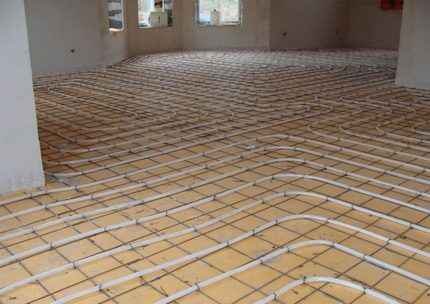
In practice, this option is used extremely rarely. In addition, it is only permissible in the first floors of multi-storey buildings due to the impressive weight of the floor with screed, for which the floors were not designed, and because of the likelihood of leaks and an overly costly, complex emergency response plan.
Option No. 2. Connecting the system to the heating boiler. There are subtleties here too. SNiPs prohibit heating floors above 30ºС, so the coolant temperature cannot be higher than 35ºС.
Standard boilers heat the liquid to higher temperatures, on average up to 65-95ºС. Therefore, additional equipment will be required to reduce the coolant temperature.
For these purposes, the so-called mixing unit, in which the hot liquid is mixed with the cold liquid coming from the return pipe.
An exception is condensing type boilers. These devices are capable of heating the coolant to small values, which is ideal for heated floors. In this case, installation of a mixing unit is not required.
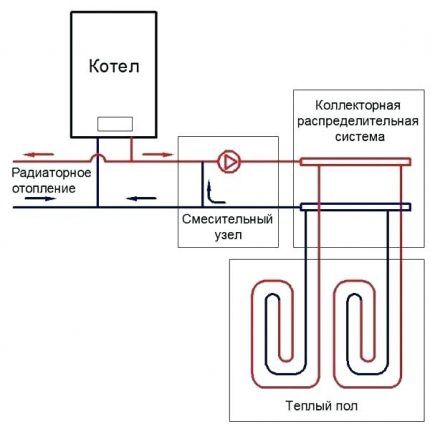
For comfortable operation of the water floor, it is provided temperature controller, working in conjunction with temperature sensors. The latter are placed in a heated room at a certain height. The information received from them is analyzed by a thermostat, which in turn controls the degree of heating of the coolant.
A more convenient option is to equip each of the collector inputs with thermostatic regulators.
Nuances of system installation
A water-type floor can be arranged in several ways. Each of them is quite complex and expensive.
Option #1. The most common method is using a screed. In this case, it is assumed that thermal insulation is first installed on a leveled base. This is a mandatory point; if it is ignored, some of the heat will go down, heating the basement.
Thus, the heating fee will be higher than necessary. The insulation thickness is calculated individually for each room.
Be sure to use additional insulation around the perimeter of the room. Damper tape or tape insulation is placed here. This is necessary to prevent heat loss through the walls and prevent the appearance of cracks due to thermal expansion.
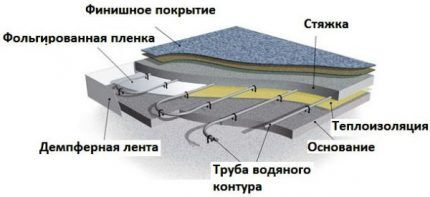
The pipes are laid directly on the thermal insulation.There are several mounting options: on a mesh reinforcing screed, on fastening tapes, on special substrate. Next, the solution is poured. This is concrete to which additives have been added to increase thermal conductivity.
The thickness of the screed should be such that there is at least 3 cm of compound above the pipes. Next, it takes time for the concrete to dry and gain strength. On average, this is at least 28 days. During this time, using heated floors is prohibited.
Among the disadvantages of this method of arranging the system, the most significant can be identified:
- large mass, which puts a significant load on the carriers;
- low maintainability — in case of a leak, you will have to dismantle the floor covering and break the screed;
- significant height - on average, taking into account the insulation, the water floor has a height of about 9-10 cm, which significantly reduces the height of the room.
Option No. 2. The so-called flooring system. In this case, the pipes are laid without using a screed. Special plates are used to form the structure. They can be made of polystyrene or wood.
Grooves are formed on the sheets into which it is convenient to lay pipes. Considering that the material has low thermal conductivity, the plates must be supplemented with metal elements.
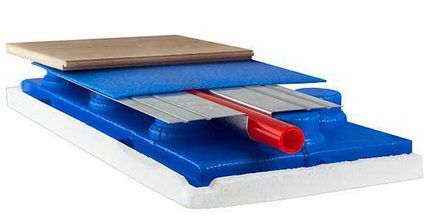
The topcoat can be applied directly to wood sheets. In the case of polystyrene, an additional solid base for finishing will be required.
This installation method is less labor-intensive and expensive.An additional advantage is that the flooring system can lay on wooden floorsbecause its weight is small. In general, installation of water heating is quite complicated.
Why choose a water floor
In general, heated floors are a very effective way to heat a home. The temperature distribution with such heating is very favorable for humans. The air warms up evenly, with the warmest zone being formed in the lower part of the room, and a little cooler at head level.
There are no convective currents characteristic of the use of spot heating devices that carry dust and microorganisms.
Water floors can be used as an additional or as the main source of heat. For relatively warm regions, the second option is preferable. For areas with harsh climates, the first choice is the best choice. The main thing is to pre- calculate the system, correctly determine the diameter of the pipes and the laying pitch.
In addition to high efficiency, it allows you to significantly save on heating. If two heating circuits are laid from the boiler, the heated liquid will first go to the radiators.
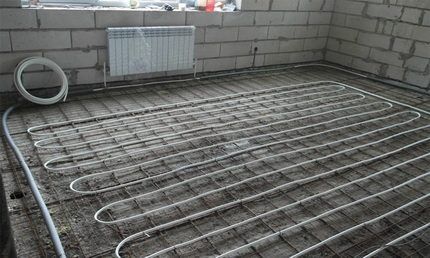
After it has cooled a little, it is served on a warm floor, where it will cool even more. After this, the coolant is sent to the boiler. As a result, the user receives maximum heat output in one heating session. The room will be heated as quickly and efficiently as possible.
In addition to undeniable advantages, a water floor also has disadvantages.The most significant is the high costs of setting up the system.
The cost of components is high, and the cost of installation, given all its complexity, is also high. However, these costs are fully recouped during its use. Water floors are effective, their efficiency is quite high. All this makes the cost of their operation minimal.
To be fair, it is worth noting that the cost of heating the coolant depends on the type of boiler used. The minimum costs will be for a gas-powered device.
If the need for repairs arises, it will be easier to work with decking systems. It will be enough to dismantle the floor covering, after which access to the pipes will appear. In this case, we can talk about relatively inexpensive and simple work.
In the case of a screed, repair will most likely be impossible. To implement it, you will have to dismantle the screed itself, which is very expensive and labor-intensive. It will be easier to install a new system.
What you need to know about electrical systems
Under the general name “electric floor” there are several systems hidden at once. They differ significantly in operating principle, performance characteristics, cost, etc.
Operating principle of heated electric floors
There are two main types of systems, both of which use electricity to operate.
Option #1. Infrared heating. In this case, the rooms are heated due to infrared waves, which are emitted by a radiator placed under the floor covering. It could be flexible IR film with carbon coating or carbon rods mounted in the form of mats. In both cases the operating principle is the same.
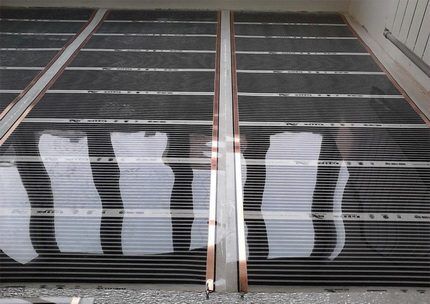
When current passes through the carbon emitter, it generates long-range infrared waves. They are absolutely safe for living beings and are felt by them as warmth.
The waves reach a dense barrier, in this case it will be the floor covering, and accumulate in it. The floor heats up on its own, after which it begins to give off its heat to the surrounding air. This process takes place very quickly - literally, in a few minutes.
To regulate the degree of heating, thermostats with mechanical or automatic control are installed.
Types of warm infrared systems:
- Film heaters — extremely convenient to use and easy to install. They are carbon strips laminated into a polymer film. The thickness of such a heater is about 3-5 mm. A winning feature is that it can be installed dry, directly under the floor covering.
- Carbon rods look like thick wire attached to a plastic mat. They can only be laid in a “wet” way, that is, in a screed. But the cost of such heaters is 15-20% lower than film heaters.
It should be remembered that there is a possibility of damage to the film, so a hard coating is required.
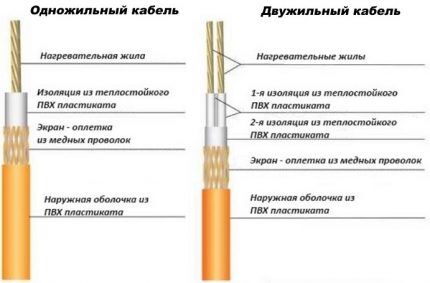
Option No. 2. Cable systems. They are also diverse. First of all, the difference lies in the type of heating cable.In all cases this is a resistive wire. Its main feature is the generation of the maximum amount of heat when electricity passes through it.
To arrange the floor, one of two types of cable is used:
- Single-core. This is the cheapest option, but its use is somewhat uncomfortable. They have only one heating core, which requires connecting the beginning and end of the wire during installation. In addition, during operation the device “gives out” a fairly large dose of electromagnetic radiation, which can negatively affect the well-being of nearby people.
- Twin-core. The cable is distinguished by the presence of a second power core. This allows you to install it with greater comfort. There is no need to connect the two ends of the heating segment, which can significantly reduce cable consumption. In addition, it emits much less, which is a significant advantage.
Both types of heaters are available either in the form of a cable or in the form of mats. In the latter case, it is a mesh sheet on which a resistive wire is attached.
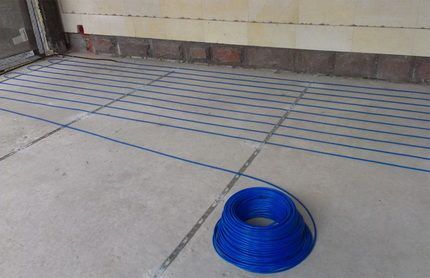
Mats are much easier to install, so this option should be preferred. In terms of cost, a single-core cable is approximately 15-20% cheaper.
A common “trouble” of resistive heaters is the dependence of the length on the amount of heat generated. It is important to correctly calculate the length of the heating filament, otherwise it will burn out. A more advanced type of resistive heater is a self-regulating cable.
Its design contains a special sensitive film matrix. It is laid between two cores. As the temperature decreases, the electrical permeability of the film begins to increase, and as it increases, it decreases.
As a result, the cable only heats up when it cools down and turns off when it gets too hot. Such heaters can be operated without connecting a thermostat, since they themselves determine the need and duration of heating.
An advantageous feature of self-regulating systems is their efficiency. In addition, their use allows you to move furniture after installing the heated floor. Resistive systems do not allow this, since the cable cannot be laid under large objects.
Otherwise, overheating and equipment failure will occur. Significant disadvantages of a self-regulating cable are the gradual loss of its properties by the matrix and high cost.
Additional information on choosing an electric heated floor is presented in this article.
Features of electrical systems arrangement
As already mentioned, only film flooring is installed using the “dry” method; other types are laid in a screed. Let's look at the main elements of a warming “pie”.
First of all, this is a leveled base - height differences should be minimal. Insulation must be laid on top of the base. It is advisable to use a metallized material to reflect thermal radiation.
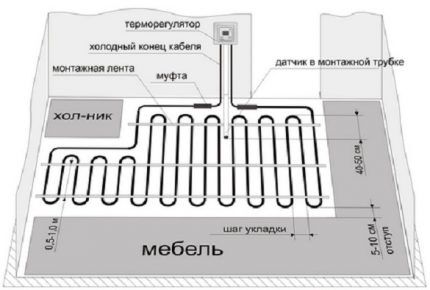
You shouldn't take a foil one, it will collapse very quickly.Be sure to install tape insulation along the walls. Next, the heaters are installed.
The most difficult option to install is cable in coils. It will need to be placed at a fairly short distance from each other and each wire securely fastened, which is very labor-intensive. It’s easier to spread film or mats.
You need to know that resistive cables and film are afraid of overheating, so they are laid only in places where bulky furniture or plumbing will not be installed. The heaters are installed in strict accordance with the instructions provided by the manufacturer.
The ends of the wires are connected to the thermostat, leading into the installation box. You can use heated floors without installing a thermostat, but then it will work ineffectively, cause excessive energy consumption and an uncomfortable room temperature.
After the test run, making sure that the system is working properly, they begin laying the screed. Usually it is placed on a reinforcing mesh. After the screed has dried, finishing work begins.
Film heaters are treated differently. Here you can lay tiles, glue is applied directly on top of the film, or you can assemble a base of plywood or similar materials for the finishing coating.
Pros and cons of electric floors
Like their water counterparts, electric floors provide quick and very uniform heating of the room with the best temperature distribution from the medical point of view. Convective currents carrying dust are also absent here. The air does not lose its humidity due to the absence of radiators.
Electrical systems are very adjustable, so you can achieve maximum efficiency in their use and achieve a comfortable room temperature.

Electric floors can be used as additional or main heating. The power of the heaters in both cases will be different, but they will do their job well.
Operation of the electrical system does not require any maintenance. With proper calculations, installation and use, the service life of such equipment is at least 30 years.
No additional equipment is required to operate electric floors. Whereas water ones, for example, need to install a heating boiler.
The only requirement is the presence of sufficient electrical wiring, otherwise the system will not be able to function normally. Among the significant disadvantages, it is necessary to note the high operating cost.
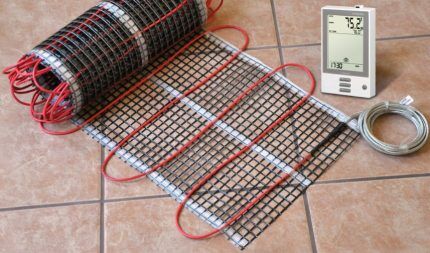
Despite their efficiency, heaters operate on electricity, which only increases its cost every year. Another minus is the need to ensure electrical safety. This is especially true for rooms where humidity is high.
It is highly desirable to create effective grounding and use an RCD. For the same reason, it is best to trust the installation to specialists.
Comparative assessment of both systems
It is impossible to answer unequivocally which type of heated floor is better.
We can only draw a few general conclusions:
- Cost of arrangement — components and installation of systems are approximately the same. It all depends on the type and operating characteristics of the system. In some cases, an electric floor can benefit from lower component costs.
- Cost of operation for water systems is much lower than for electric ones. Especially when the coolant is heated by a gas boiler.
- Design Constraints. Water systems are not used in the construction of multi-storey buildings.
- Power dependency — electrical systems depend on the presence/absence of electricity, water systems will work regardless of this.
- Maintainability. It is cheaper and easier to repair electrical systems. Water-based ones, with the exception of floor options, are difficult and expensive to repair.
In general, both types of underfloor heating have proven themselves well. They warm up rooms evenly and quickly enough, are reliable, and with proper use can last for decades.
When calculating the costs of installing a particular system, you need to remember that before installing a water floor on the first floor of an apartment building, you will need to obtain permission. This means additional costs for collecting documents.
The choice of the type of heating system is also influenced by the type of flooring; more details can be found in the articles:
- Which heated floor to choose for laminate: a comparative analysis of the best options
- Which warm floor is better for tiles: pros and cons of various solutions + review of the best manufacturers
Conclusions and useful video on the topic
Which type of electric flooring should you prefer:
Water floor system - how it works:
Comparing water and electric floors:
Warm floors of both electric and water types heat rooms equally well. The question of choice is most often purely economic, which one is cheaper.
For apartment buildings, it is easier and cheaper to install one of the electric varieties. True, operation will cost more. For private people, the best option is a water floor. Installation will cost a large amount, but subsequent operation will quickly recoup this investment.
Do you have experience installing heated floors? Please tell readers which system option you chose and why. Comment on the post, participate in discussions and ask questions. The feedback block is located below.




We installed an electric “warm floor” system in our house. We calculated that even taking into account the cost of electricity, such a system would cost us more profitably than a water one. We were pleased with the choice; the house is always comfortable, even when the heating has not yet been turned on. This system does not require any special maintenance, just set the required temperature and enjoy the warmth!
When we were doing renovations, our choice fell on electric heated floors. They are the main source of heating in our house. We understood that water floors had more advantages, but we trusted trusted specialists who convinced us that with proper installation, electric floors would be much more effective. Of course, it was not cheap, but we were pleased with the result.
The apartment has heated floors. At first we thought and calculated which ones were more profitable, but we decided on electric ones. Moreover, to install a water circuit, a lot of agreements are needed, even though we have the first floor.Now our electricity tariffs are lower than the cost of water. Of course, the installation cost us a pretty penny, but now the house is always warm and cozy. Floors are especially helpful in the fall, when the apartment is cold and the start of the heating season is still far away.